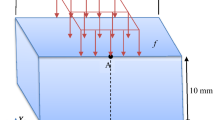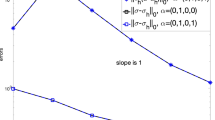Abstract
Compressible Mooney–Rivlin theory has been used to model hyperelastic solids, such as rubber and porous polymers, and more recently for the modeling of soft tissues for biomedical tissues, undergoing large elastic deformations. We propose a solution procedure for Lagrangian finite element discretization of a static nonlinear compressible Mooney–Rivlin hyperelastic solid. We consider the case in which the boundary condition is a large prescribed deformation, so that mesh tangling becomes an obstacle for straightforward algorithms. Our solution procedure involves a largely geometric procedure to untangle the mesh: solution of a sequence of linear systems to obtain initial guesses for interior nodal positions for which no element is inverted. After the mesh is untangled, we take Newton iterations to converge to a mechanical equilibrium. The Newton iterations are safeguarded by a line search similar to one used in optimization. Our computational results indicate that the algorithm is up to 70 times faster than a straightforward Newton continuation procedure and is also more robust (i.e., able to tolerate much larger deformations). For a few extremely large deformations, the deformed mesh could only be computed through the use of an expensive Newton continuation method while using a tight convergence tolerance and taking very small steps.




Similar content being viewed by others
References
Holzapfel G (2000) Nonlinear solid mechanics: a continuum approach for engineering. Wiley, London
Ciarlet P, Geymonat G (1982) Sur les lois de comportement en élasticité non-linéaire compressible. C R Acad Sci Paris Sér II 295:423–426
Mooney M (1940) A theory of large elastic deformation. J Appl Phys 11:582–592
Gibson L, Ashby M (1997) Cellular solids. Structure and properties, 2nd edn. Cambridge University Press, Cambridge
Weichert F, Schröder A, Landes C, Shamaa A, Awad SK, Walczak L, Müller H, Wagner M (2010) Computation of a finite element-conformal tetrahedral mesh approximation for simulated soft tissue deformation using a deformable surface model. Med Biol Eng Comput 48:597–610
Belytschko T, Liu W, Moran B (2000) Nonlinear finite elements for continua and structures. Wiley, New York
Hughes TJR (2000) The finite element method: linear static and dynamic finite element analysis. Dover Publishers, New York
Keast P (1986) Moderate-degree tetrahedral quadrature formulas. Comput Methods Appl Mech Eng 55:339–348
Shontz S, Vavasis S (2010) Analysis of and workarounds for element reversal for a finite element-based algorithm for warping triangular and tetrahedral meshes. BIT Numer Math 50(4):863–884
Wright S (1997) Primal-dual interior-point methods. Society for Industrial and Applied Mathematics, Philadelphia
Stein K, Tezduyar T, Benney R (2003) Moving mesh techniques for fluid–structure interactions with large displacements. J Appl Mech (ASME) 70:58–63
Shontz SM (2005) Numerical methods for problems with moving meshes. Ph.D. Thesis. Cornell University
Freitag L, Plassmann P (2000) Local optimization-based simplicial mesh untangling and improvement. Int J Numer Methods Eng 49:109–125
Golub GH, Van Loan CF (1996) Matrix computations, 3rd edn. Johns Hopkins University Press, Baltimore
Dennis JE Jr, Schnabel RB (1996) Numerical methods for unconstrained optimization and nonlinear equations. Society for Industrial and Applied Mathematics, Philadelphia
Shewchuk J (1996) Triangle: engineering a 2D quality mesh generator and Delaunay triangulator. In: Proceedings of the first workshop on applied computational geometry. Association for Computing Machinery, pp 124–133
Knupp P (2003) Sandia National Laboratories, personal communication
Shephard M, Dey S, Georges M (1995) Automatic meshing of curved three-dimensional domains: curving finite elements and curvature-based mesh control. In: Babuska I, Flaherty J, Hopcroft J, Henshaw W, Oliger J, Tezduyar T (eds) Modeling, mesh generation, and adaptive numerical methods for partial differential equations. Springer, New York
Vavasis S (2003) A Bernstein-Bézier sufficient condition for invertibility of polynomial mappings. Archived by arxiv.org, cs.NA/0308021
Salem A, Canann S, Saigal S (1997) Robust quality metric for quadratic triangular 2D finite elements. Trends Unstruct Mesh Gener 220:73–80
Salem A, Canann S, Saigal S (2001) Mid-node admissible spaces for quadratic triangular 2D arbitrarily curved finite elements. Int J Numer Methods Eng 50:253–272
Salem A, Canann S, Saigal S (2001) Mid-node admissible spaces for quadratic triangular 2D finite elements with one edge curved. Int J Numer Methods Eng 50:181–197
Salem A, Saigal S, Canann S (2001) Mid-node admissible space for 3D quadratic tetrahedral finite elements. Eng Comput 17:39–54
Nocedal J, Wright SJ (2006) Numerical optimization, 2nd edn. Springer, Berlin
Acknowledgments
The authors wish to thank Patrick Knupp of Sandia National Laboratories for providing us with the 3D test meshes. They benefited from many helpful conversations with Katerina Papoulia of University of Waterloo. They also wish to thank the anonymous referees for their careful reading of the paper and for their helpful suggestions which strengthened it. The work of S.M. Shontz was supported by a fellowship from the National Physical Science Consortium (with support from Sandia National Laboratories and Cornell University) and was supported in part by NSF grants ACI-0085969, CNS-0720749, and NSF CAREER Award OCI-1054459. The work of S.A. Vavasis was supported in part by NSF grant ACI-0085969, a Discovery grant from NSERC (Canada), and a grant from the U.S. Air Force Office of Scientific Research.
Author information
Authors and Affiliations
Corresponding author
Additional information
Much of the work of S. M. Shontz was performed while she was a graduate student in the Center for Applied Mathematics at Cornell University.
Rights and permissions
About this article
Cite this article
Shontz, S.M., Vavasis, S.A. A robust solution procedure for hyperelastic solids with large boundary deformation. Engineering with Computers 28, 135–147 (2012). https://doi.org/10.1007/s00366-011-0225-y
Received:
Accepted:
Published:
Issue Date:
DOI: https://doi.org/10.1007/s00366-011-0225-y




